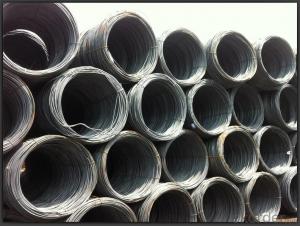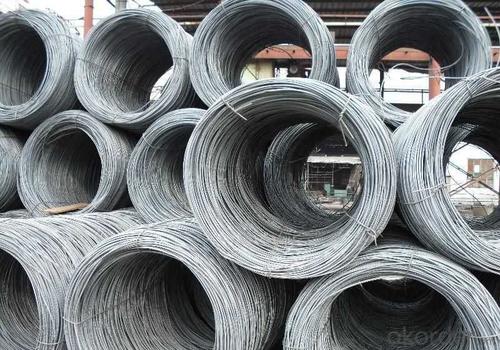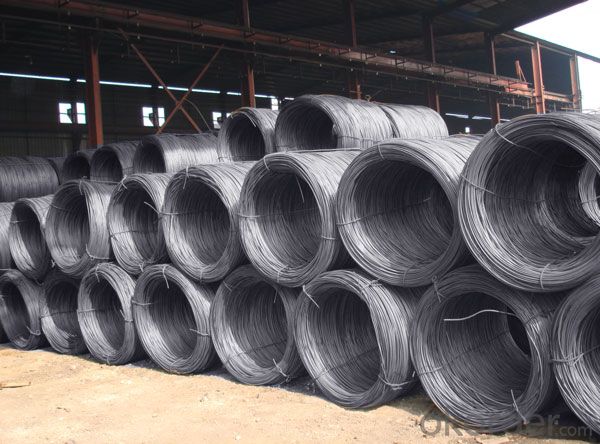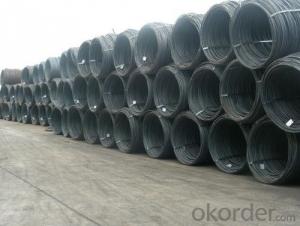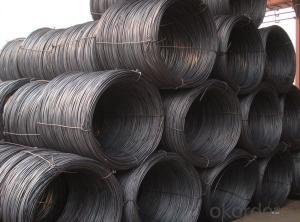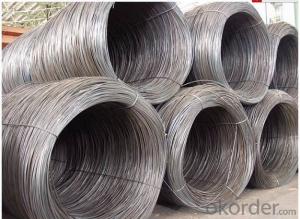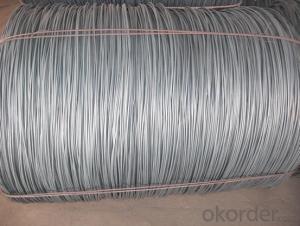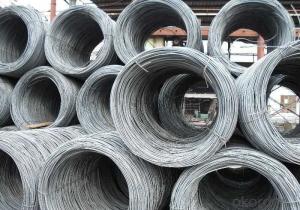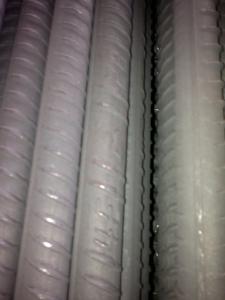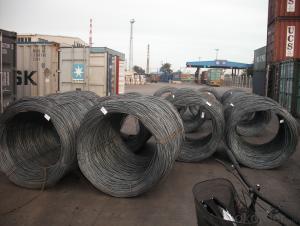Hot Rolled Steel Wire Rod SAE1006 5.5MM-14MM
- Loading Port:
- Tianjin
- Payment Terms:
- TT or LC
- Min Order Qty:
- 25 m.t.
- Supply Capability:
- 100000 m.t./month
OKorder Service Pledge
OKorder Financial Service
You Might Also Like
Product Description:
OKorder is offering high quality Hot Rolled Steel Wire Rod SAE1006 5.5MM-14MM at great prices with worldwide shipping. Our supplier is a world-class manufacturer of steel, with our products utilized the world over. OKorder annually supplies products to European, North American and Asian markets. We provide quotations within 24 hours of receiving an inquiry and guarantee competitive prices.
Product Applications:
After hot-rolled the products shaped into coil and delivery as finished product, including round, square, rectangular, hexagonal and so on. Since most of the products are round, it is generally called wire rod. Carbon steel wire rod is widely used in construction and manufacturing. Carbon steel wire rod is mainly used for reinforcement of reinforced concrete and welded structure or reprocessed (roberts , nail, etc.) materials, especially used to produce wire drawing, welding electrode, nails, spring, electronic, precise machinery parts and so on.
Product Advantages:
OKorder's Hot Rolled Steel Wire Rod SAE1006 5.5MM-14MMare durable, strong, and resist corrosion.
Main Product Features:
· Premium quality
· Prompt delivery & seaworthy packing (30 days after receiving deposit)
· Corrosion resistance
· Can be recycled and reused
· Mill test certification
· Professional Service
· Competitive pricing
Product Specifications:
Manufacture: Hot rolled
Grade: SAE1008 SAE 1006
Certificates: ISO, SGS, BV, CIQ
Diameter: 5.5mm, 6.5mm, 7mm,8mm,9mm,10mm,12mm,14mm, as per customer request
Packaging: Export packing, nude packing, bundled
Grade | Chemical Composition (%) | |||||
C | Mn | S | P | Si | B | |
SAE1008B | 0.10max | 0.32max | 0.045max | 0.040max | 0.30max | 0.0008min |
Mechanical properties | ||||||
Yield strength(N/mm2) | Tensile strength(N/mm2) | Elongation (%) | ||||
≥195 | 350-380 | ≥32 | ||||
FAQ:
Q1: Why buy Materials & Equipment from OKorder.com?
A1: All products offered byOKorder.com are carefully selected from China's most reliable manufacturing enterprises. Through its ISO certifications, OKorder.com adheres to the highest standards and a commitment to supply chain safety and customer satisfaction.
Q2: What makes stainless steel stainless?
A2: Stainless steel must contain at least 10.5 % chromium. It is this element that reacts with the oxygen in the air to form a complex chrome-oxide surface layer that is invisible but strong enough to prevent further oxygen from "staining" (rusting) the surface. Higher levels of chromium and the addition of other alloying elements such as nickel and molybdenum enhance this surface layer and improve the corrosion resistance of the stainless material.
Q3: Can stainless steel rust?
A3: Stainless does not "rust" as you think of regular steel rusting with a red oxide on the surface that flakes off. If you see red rust it is probably due to some iron particles that have contaminated the surface of the stainless steel and it is these iron particles that are rusting. Look at the source of the rusting and see if you can remove it from the surface.
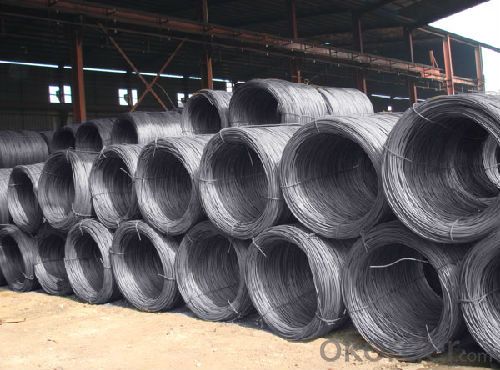
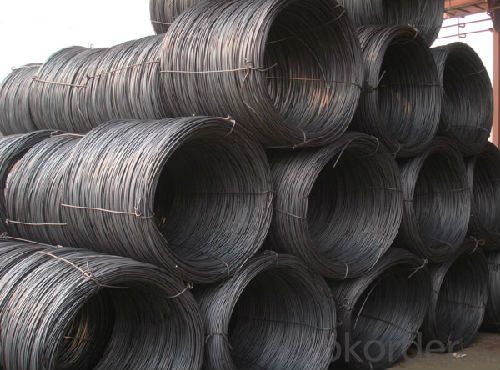
- Q: What are the common applications of high-strength and oil tempered steel wire rod?
- Due to its unique properties, high-strength and oil tempered steel wire rod find a wide range of applications in various industries. Some common uses include: 1. In the automotive industry, high-strength steel wire rod is utilized for suspension springs, engine valve springs, clutch springs, and seat springs due to its exceptional tensile strength and fatigue resistance. 2. The construction industry relies on steel wire rod for pre-stressed concrete structures, post-tensioning systems, and reinforcement in concrete structures. Its high strength contributes to structural stability and durability. 3. In the manufacturing industry, steel wire rod is employed in the production of wire ropes, cables, springs, and fasteners. Its strength and elasticity make it ideal for applications requiring flexibility and durability. 4. The electrical industry uses steel wire rod for the manufacturing of electrical conductors, such as overhead power lines and electrical cables. Its high conductivity and strength facilitate efficient transmission of electricity over long distances. 5. In the agriculture industry, steel wire rod is used in the manufacturing of fencing materials, barbed wires, and support structures for crops. Its strength and durability ensure effective protection and support for agricultural fields. 6. The furniture industry incorporates steel wire rod in the production of furniture items such as springs for mattresses and seating arrangements. Its ability to withstand heavy loads and provide comfort makes it a popular choice. In summary, high-strength and oil tempered steel wire rod are extensively utilized in various industries due to their exceptional strength, durability, and flexibility.
- Q: What are the standard bending requirements for steel wire rod?
- The standard bending requirements for steel wire rod depend on the specific application and industry standards. However, some common bending requirements for steel wire rod include achieving a specific radius or angle without causing cracking, breaking, or excessive deformation of the material. These requirements are often specified in terms of minimum bend radii, maximum bend angles, and acceptable levels of distortion or elongation. It is important to consult the relevant industry standards and guidelines to ensure compliance with the specific bending requirements for steel wire rod.
- Q: How is steel wire rod used in the manufacturing of wire ropes?
- Steel wire rod is used as the primary raw material in the manufacturing of wire ropes. The rod is first drawn through a series of dies to reduce its diameter while increasing its length. This process, called wire drawing, results in a long, thin wire that is strong and flexible. The drawn wire is then twisted together with other wires to form strands, which are further twisted around a central core to create the wire rope. The steel wire rod's high tensile strength and durability make it an ideal choice for wire rope manufacturing, ensuring the ropes can withstand heavy loads and harsh conditions.
- Q: What are the different types of steel wire rod coatings used for anti-corrosion properties?
- Steel wire rod coatings are commonly used to prevent corrosion. There are various types of coatings available for this purpose. 1. Zinc Coatings: Zinc coatings, like galvanized coatings, are widely used for their anti-corrosion properties. These coatings create a protective layer of zinc on the steel wire rod surface, acting as a barrier against corrosion. Zinc coatings can be applied through hot-dip galvanizing or electroplating. 2. Aluminum Coatings: Another type of coating used for anti-corrosion is aluminum coatings. These coatings can be applied through hot-dip aluminizing or thermal spraying. They form a protective layer that prevents contact between the steel wire rod and corrosive substances. 3. Epoxy Coatings: Epoxy coatings, a type of organic coating, are commonly used for anti-corrosion purposes. They are applied as a liquid and then cured to create a hard and durable protective layer on the steel wire rod surface. Epoxy coatings offer excellent resistance against corrosion and can withstand harsh environments. 4. Polymer Coatings: Polymer coatings, such as polyethylene or polypropylene coatings, are frequently used for anti-corrosion properties. These coatings are typically applied through extrusion or powder coating. Polymer coatings provide a protective layer that is resistant to chemicals, moisture, and other corrosive elements. 5. Ceramic Coatings: Ceramic coatings are highly resistant to corrosion and wear. They are applied through thermal spraying or chemical vapor deposition. Ceramic coatings create a hard and dense layer on the steel wire rod surface, offering excellent protection against corrosion. Choosing the right coating depends on factors such as the environment, operating conditions, and desired level of corrosion resistance. Each type of coating has its own advantages and limitations, so it is crucial to select the most suitable one for long-term anti-corrosion protection of the steel wire rod.
- Q: What are the different types of steel wire rod finishes for improved surface hardness?
- There are several types of steel wire rod finishes that can improve surface hardness. Some common finishes include galvanizing, coating with zinc or other metals, heat treatment, and cold drawing. These finishes enhance the hardness of the wire rod surface, making it more resistant to wear and damage.
- Q: What are the different types of steel wire rod surface defect quantification methods?
- There are several different methods used to quantify surface defects on steel wire rods. These include visual inspection, optical microscopy, image analysis, and non-destructive testing techniques such as ultrasonic testing and magnetic particle inspection. Each method has its own advantages and limitations, but they all aim to accurately measure and classify surface defects on steel wire rods to ensure quality control and compliance with industry standards.
- Q: What are the common applications of galvanized steel wire rod?
- Some common applications of galvanized steel wire rod include fencing, construction reinforcement, wire mesh production, electrical wiring, and manufacturing of various industrial products such as springs, clips, and fasteners.
- Q: How is steel wire rod used in the production of wire for mattress springs?
- Steel wire rod is used in the production of wire for mattress springs as it serves as the primary material for manufacturing the springs. The wire rod undergoes a series of processes such as drawing, annealing, and coiling to transform it into a fine, strong, and resilient wire that is then used to create the springs found within mattresses.
- Q: What are the common production processes for zinc-coated steel wire rod?
- The common production processes for zinc-coated steel wire rod include wire drawing, cleaning and pickling, zinc coating through either hot-dip galvanizing or electroplating, and final inspection and packaging.
- Q: What are the different grades of steel wire rods?
- There are several different grades of steel wire rods, including low carbon, medium carbon, high carbon, and alloy steel grades. Each grade has its own unique properties and characteristics, making them suitable for various applications in industries such as construction, automotive, and manufacturing.
Send your message to us
Hot Rolled Steel Wire Rod SAE1006 5.5MM-14MM
- Loading Port:
- Tianjin
- Payment Terms:
- TT or LC
- Min Order Qty:
- 25 m.t.
- Supply Capability:
- 100000 m.t./month
OKorder Service Pledge
OKorder Financial Service
Similar products
Hot products
Hot Searches
Related keywords


